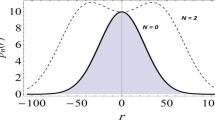Abstract
In this paper, the spectral efficiency and quantum limit for transmission of a BPSK signal in a WDM system are computed after analyzing the error probability in the presence of component crosstalk. The analysis of bit error rate (BER) is derived from the non-Gaussian probability density function for finite (N) interferers obtained using a new mathematical formulation employing Maclaurin series expansion of the Nth power of zero-order Bessel function. The model is verified with the experimental data taken from the literature. The effects of number of interfering channels, SNR and data rate on BER are studied. Results show how spectral efficiency and quantum limit deviate from ideal values due to the presence of interferers. The spectral efficiency decreases with the appearance of interferers, thus escalating the transmission cost per bit. From the study of quantum limit, it is seen that the minimum number of photons per bit required for BPSK transmission is to be increased to maintain a fixed BER as the number of interferers increases.







Similar content being viewed by others
References
Jara, N., Vallejos, R., Rubino, G.: Blocking evaluation and wavelength dimensioning of dynamic WDM networks without wavelength conversion. IEEE/OSA J. Opt. Commun. Netw. 9(8), 625–634 (2017). https://doi.org/10.1364/JOCN.9.000625
Sarkar, S., Das, N.R.: Study of component crosstalk and obtaining optimum detection threshold for minimum bit-error-rate in a WDM receiver. J. Lightwave Tech. 27, 4366–4373 (2009)
Goldstein, E.L., Eskildsen, L., Elrefaie, A.F.: Performance implications of component crosstalk in transparent lightwave networks. IEEE Photon. Technol. Lett. 6(5), 657–660 (1994). https://doi.org/10.1109/68.285571
Winzer, P.J.: High-spectral-efficiency optical modulation formats. J. Lightwave Technol. 30(24), 3824–3835 (2012)
Millar, D.S., Koike-Akino, T., Arık, S.Ö., Kojima, K., Parsons, K., Yoshida, T., Sugihara, T.: High-dimensional modulation for coherent optical communications systems. Opt. Express 22(7), 8798–8812 (2014)
Dalakas, V., Kamalakis, T.: Comparative study of modulation and coding schemes for coherent indoor optical wireless systems. Opt. Quant. Electron. 48, 374 (2016)
Mukherjee, P., Sarkar, S., Das, N.R.: An approach for realistic estimation of BER due to signal-component crosstalk in a WDM receiver. Optik 146, 1–7 (2017)
Ho, K.P.: Analysis of homodyne crosstalk in optical networks using Gram-Charlier Series. J. Lightwave Technol. 17(2), 149–154 (1999)
Kamalakis, T., Sphicopoulos, T.: Asymptotic behavior of in-band crosstalk noise in WDM networks. IEEE Photon. Technol. Lett. 15(3), 476–478 (2003)
Ho, K.P.: Effects of homodyne crosstalk on dual-polarization QPSK signals. J. Lightwave Technol. 29(1), 124–131 (2011). https://doi.org/10.1109/JLT.2010.2095830
Camatel, S., Ferrero, V.: Homodyne coherent detection of ASK and PSK signals performed by a subcarrier optical phase-locked loop. IEEE Photon. Technol. Lett. 18(1), 142–144 (2006)
Camatel, S., Ferrero, V.: 2.5-Gb/s BPSK ultradense WDM homodyne coherent detection using a subcarrier-based optical phase-locked loop. IEEE Photon. Technol. Lett. 18(18), 1919–1921 (2006)
Ho, K.-P.: Phase-modulated optical communication systems. Springer, New York (2005)
Kahn, J.M., Ho, K.-P.: Spectral efficiency limits and modulation/detection techniques for DWDM systems. IEEE J. Sel. Top. Quantum Electron. 10(2), 259–272 (2004)
Yan, L.-S., Liu, X., Shieh, W.: Toward the Shannon limit of spectral efficiency. Photon. J. IEEE 3(2), 325–330 (2011)
Essiambre, R.-J., Tkach, R.W.: Capacity trends and limits of optical communication networks. Proc. IEEE 100(5), 1035–1055 (2012)
Fan, X., Bai, P., Liang, X., Zhang, J., Liu, B.: Detection algorithm of BPSK signal of parameter-adjusted bistable stochastic resonance model based on scale change. IEEE Access 8, 97643–97657 (2020). https://doi.org/10.1109/ACCESS.2020.2997705
Rabiei, A.M., Beaulieu, N.: An analytical expression for the BER of an individually optimal single cochannel interferer BPSK receiver. IEEE Trans. Commun. 55(1), 60–63 (2007)
Rabiei, A.M., Beaulieu, N.C.: A simple, intuitive expression for the BER of a jointly optimal single cochannel interferer BPSK receiver. IEEE Commun. Lett. 9(3), 201–203 (2005)
Saberali, S.M., Amindavar, H., Moghaddamjoo, A.R.: BER calculation and investigation of optimal single user detector for a BPSK signal contaminated by cochannel interferer. IEEE Commun. Lett. 12(10), 705–707 (2008)
Chung, K.: An analytical expression for the BER of optimal single user detection of a BPSK signal contaminated by multiple CCIs. EURASIP J. Wirel. Commun. Netw. 190, 2012 (2012)
Darshi, S., Bhattacharjee, R.: BER analysis of asynchronised wireless network in presence of non-identically distributed interferers. Wirel. PersCommun. 82, 2583–2600 (2015)
Baricz, A.: Powers of modified Bessel functions of the first kind. Appl. Math. Lett. 23(6), 722–724 (2010)
Abramowitz, A., Stegun, I.: Handbook of mathematical functions, 9th edn. Dover, New York (1972)
Papoulis, A.: Probability, random variable, and stochastic processes. McGraw-Hill, New York (1984)
Proakis, J.G.: Digital communications. McGraw-Hill, New York (2000)
Aldis, J.P., Burr, A.G.: The channel capacity of discrete time phase modulation in AWGN. IEEE Trans. Inf. Theory 39, 184–185 (1993)
Kramer, G., Ashikhmin, A., van Wijngaarden, A.J., Wei, X.: "Spectral efficiency of coded phase-shift keying for fiber-optic communication. J. Lightwave Technol. 21(10), 2438–2445 (2003). https://doi.org/10.1109/JLT.2003.817704
Verdu, S.: Spectral efficiency in the wideband regime. IEEE Trans. Inf. Theory 48(6), 1319–1343 (2002). https://doi.org/10.1109/TIT.2002.1003824
Antonelli, C., Mecozzi, A., Shtaif, M., Winzer, P.J.: Quantum Limits on the Energy Consumption of Optical Transmission Systems. J. Lightwave Technol. 32(10), 1853–1860 (2014)
Jarzyna, M.: Classical capacity per unit cost for quantum channels. Phys. Rev. A 96, 032340 (2017)
Glance, B.: Performance of homodyne detection of binary PSK optical signals. J. Lightwave Technol. 4(2), 228–235 (1986). https://doi.org/10.1109/JLT.1986.1074700
Stevens, M.L., Caplan, D.O., Robinson, B.S., Boroson, D.M., Kachelmyer, A.L.: Optical homodyne PSK demonstration of 15 photons per bit at 156 Mbps with rate-1/2 turbo coding. Opt. Express 16, 10412–10420 (2008)
Kakarla, R., Schröder, J., Andrekson, P.A.: One photon-per-bit receiver using near-noiseless phase-sensitive amplification. Light Sci. Appl. 9, 153 (2020). https://doi.org/10.1038/s41377-020-00389-2
Author information
Authors and Affiliations
Corresponding author
Additional information
Publisher's Note
Springer Nature remains neutral with regard to jurisdictional claims in published maps and institutional affiliations.
Rights and permissions
About this article
Cite this article
Mukherjee, P., Sarkar, S. & Das, N.R. Spectral efficiency and quantum limit of BPSK transmission in a WDM system in presence of multiple interferers. Photon Netw Commun 42, 134–141 (2021). https://doi.org/10.1007/s11107-021-00945-9
Received:
Accepted:
Published:
Issue Date:
DOI: https://doi.org/10.1007/s11107-021-00945-9




